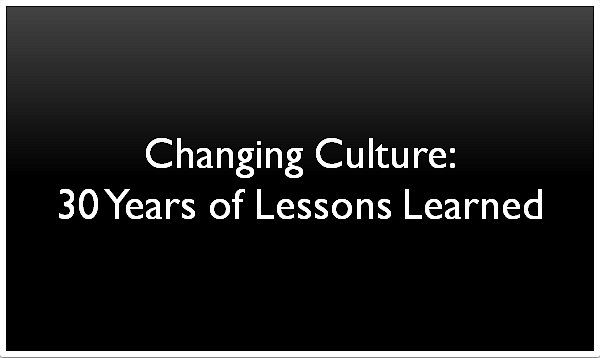Who should participate in the conversation? The answer is simply anyone and everyone – the more the better. Of course, this may not be possible for practical reasons. The important thing is diversity. You want to engage people at different levels, genders, tenure, professions, locations and so on. Ideally, those involved are credible influencers, the people others look to for guidance, as they can spread understanding and help shift the culture if needed. If you can add the perspective of people outside the organization, even better. Outsiders often notice things that insiders are oblivious to. This might include customers, suppliers, analysts or even competitors.
Culture Change: What and Why
Culture Change: What and Why

Culture Change: Getting Off To The Right Start
In order to change or improve upon your company’s culture, you must first understand it, and the only way to understand it is to ask the right questions. If you simply ask employees to describe the culture or tell you how “things get done around here,” you’re probably going to get blank stares. This is where the who, why and what culture conversation can help.
Question #1 – Who?
Question #2 – Why?
The conversation starts with generating a whole pile of ‘Why’ questions that begin with ‘Why do we do X this way?’ where X is replaced with descriptions drawn from people’s experience. For example, why do Maple Leaf players stay at a hotel when they are in Toronto for a playoff game? Why do the Leaf’s suspend players who are late for a practice? Why do they have a Father and Son weekend? Generate as many questions as possible and don’t worry about filtering or critiquing them. This comes later. You’re looking for a comprehensive description of the way things get done around here.
Every ‘why’ question has the potential to be meaningful but I like to start with the questions that people want to talk about; where they have the most energy. These are often the ones that are the most revealing. Once you’ve worked through these, you can decide how to handle the others. A word of caution, in an effort to go quickly, people are prone to say that a question is like one that has already been discussed so it can be skipped. A quick test is to go around the room and ask people to say or write down their answers. If something different emerges or views differ, it should be discussed.
As each question is answered, write down the beliefs and assumptions that emerge keeping in mind that people may see things differently. For example, one person might see the Leaf’s Father and Son weekend as nothing more than a perk of the job while someone else believes it symbolizes the importance of family. But, what is ‘family’ and why is it important? You might get to something like we believe a solid support system (including the family at home) is essential for professional hockey players to successfully navigate the good and bad times that all players experience. One way of thinking about this conversation is to recall an interaction with an inquisitive two-year old. Why are you doing that? Buy why? But why? Eventually, you will have developed a core set of beliefs and assumptions. You will know you’re there when every new question results in the same answers or challenges a defined belief.
Question #3 – What?
Chances are good, you will also have a list of ‘why questions’ that don’t fit with the belief system. For example, why aren’t mothers included in the Father and Son weekend? Aren’t they part of the player’s support system? Does this mean mothers aren’t as important as fathers? This leads to the ‘What’ question which is “What does this say about our beliefs?” This conversation is about questioning current behaviors, practices, and ways of doing things to identify inconsistencies that send mixed messages and serve to undermine the culture. It can, however, also raise questions about the core beliefs and assumptions.
What is to say that the outliers aren’t actually better or more appropriate for the organization? This introduces a new line of questioning. It starts with a macro question such as what is our vision, mission and/or purpose? What is our strategy? What do our customers expect/need? Given this, do our existing beliefs and assumptions make sense or do they need to change?
The bottom line is that what worked in the past may not be what is needed to be successful today and in the future. To use an example from the corporate world, an organization may have been successfully operating with the belief that the best way to mitigate risk is through a system of controls that includes restrictive delegation of authority and hierarchical decision-making. But what if the world around them starts to change and they need to be able to make decisions and change directions quickly to remain competitive? The existing belief system now acts as a barrier. Unless this is changed, and with it, related behaviors, practices, and structures, the culture will get in the way of any effort to be agile.
The Importance Of The Why and What of Culture Change
People learn and remember things by being explicit about them. If an employee is doing something in a certain way, say a way that is not ideal for the organization, they may simply be doing it that way because they never thought about it. But when you draw information from people via what and why style culture conversations, you naturally get them to consider their behaviors in a more critical way than they would have otherwise. Moreover, when you come across cultural problems in these conversations people feel they are in part responsible for identifying them, and when people feel they helped to identify a problem, they are more likely to help you fix it. What and why conversations are a powerful and effective technique to help people understand their company’s culture in a meaningful way. Meaningful, especially, in that they can reveal the beliefs, assumptions, and values that are deeply embedded in the collective psyche of an organization.
If You Need Help With Culture Change, We’re Here to Help











